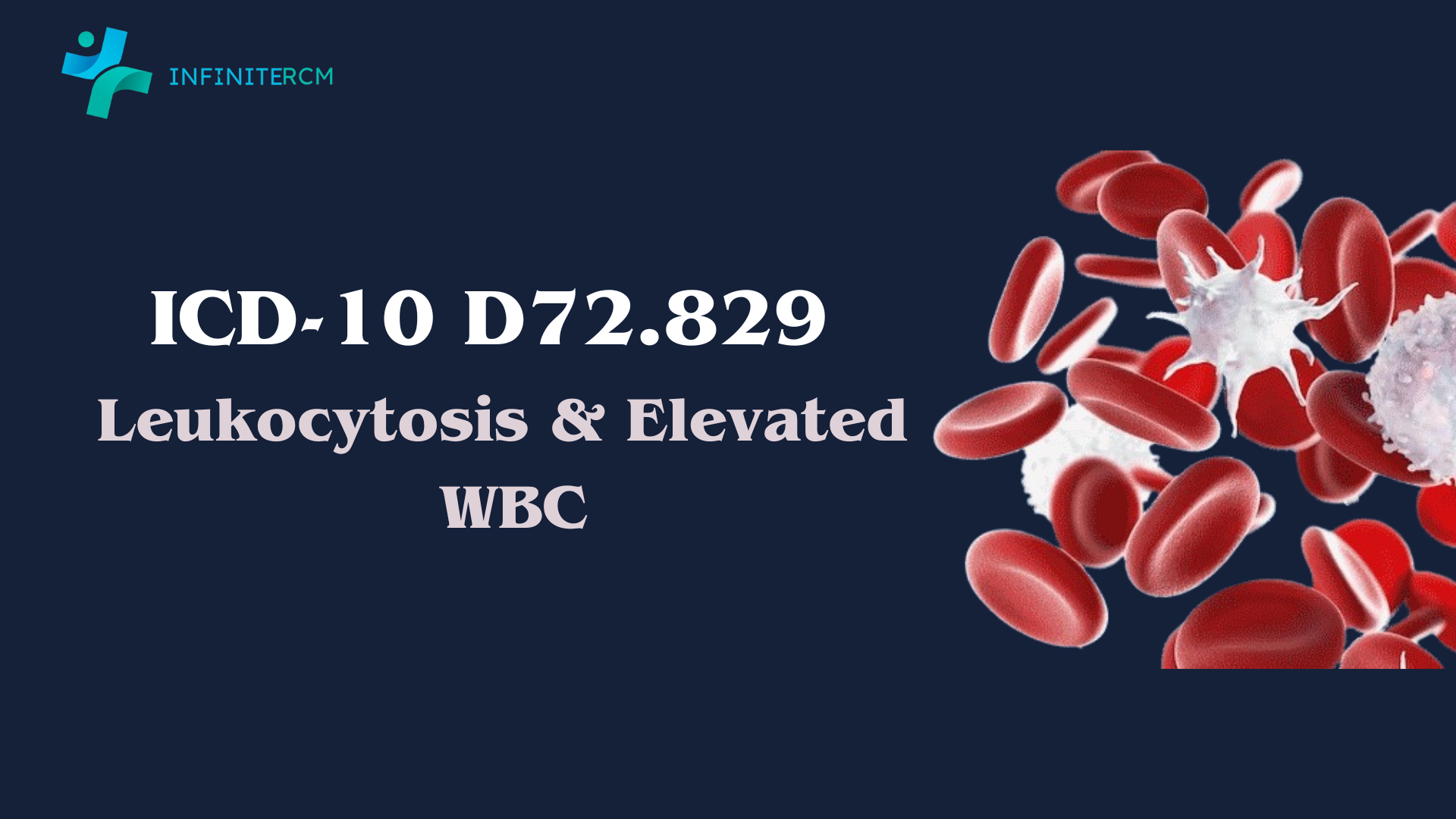Subtotal $0.00
ICD stands for International Classification of Diseases. This coding system is used in clinical and healthcare settings to document patient information. These codes describe the patient’s diagnosis and medical condition. The codes facilitate communication between;
- Medical Experts.
- Healthcare Providers.
- Billing Companies.
- Insurance Agencies.
- Stakeholders.
ICD-10 codes tell us about injuries, accidents, and causes of death. These codes are used for;
- Patient’s Diagnosis.
- Support Medical Billing.
- Helps Insurance Claims.
- Gather Public Health Data.
ICT -10 codes consist of alphabets, numbers, and extensions. These show categories, subcategories, and specific complications respectively. Alphabets from A-Z except U, Numbers from 0-9, and extensions like x or point are used. There are 21 chapters with over 155,000 codes. Remember that all these codes are updated annually by the WHO.
ICD-10 Code for Leukocytosis
The ICD-10 code for leukocytosis is D72.82 Elevated white blood cell count.
- Chapter and Section: D72.82 falls under Chapter 3 and Section D70-D77, specifically addressing “Other disorders of blood and blood-forming organs.”
- Category: It belongs to Category D72, focusing on “Other disorders of white blood cells.”
- Parent Code: “D72.82” encompasses “Elevated white blood cell count.”
- Extension 829: This extension adds crucial details related to etiology, anatomic site, severity, and other essential information.
Other relevant ICD-10 Codes include:
D72.810 (lymphocytopenia):
The ICD-10 code D72.810 refers to lymphocytopenia. It is a condition with a lower-than-normal number of lymphocytes in the blood. Here’s a breakdown of the code:
- D72: This category encompasses other disorders of white blood cells.
- D72.81: This subcategory refers specifically to decreased white blood cell count.
- D72.810: This code pinpoints lymphocytopenia.
D72.818 (Other elevated white blood cell count)
D72.818 is an ICD-10 code that signifies other decreased white blood cell count. It falls under “Other disorders of white blood cells”. Here’s a more detailed explanation:
- D72: This category covers various disorders affecting white blood cells.
- D72.81: This subcategory specifically concerns a decreased white blood cell count.
- D72.818: This code indicates “other” decreased white blood cell count.
D72.819 (Elevated white blood cell count, without further specification)
D72.819 ICD-10 code stands for unspecified decreased white blood cell count. It’s important to note that “decreased” here refers to a lower-than-normal white blood cell count.
- D72: This category encompasses diseases of the blood and blood-forming organs.
- D72.81: This subcategory refers specifically to a decreased white blood cell count.
- D72.819: This code indicates a decreased white blood cell count without specifying the type of white blood cells affected.
D72.823 Neutrophilic Leukocytosis (leukemoid reaction)
There’s no single code for neutrophilic leukocytosis, D72.82 or D72.823 might be used depending on the severity and context. D72.823 code stands for leukemoid reaction. It signifies a very high white blood cell count, often seen in response to severe infections or inflammations.
- D72: This category covers other disorders of white blood cells.
- D72.82: This subcategory refers specifically to elevated white blood cell count.
- D72.823: This code pinpoints a leukemoid reaction, a specific type of elevated white blood cell count.
ICD-10 Code for Leukocytosis Unspecified
D72.82 is a general code and might not be ideal for reimbursement purposes in some healthcare settings.
- D72.82 falls under the category “Disorders of white blood cells, unspecified” (D72).
- It specifically refers to an increased white blood cell count, which is the defining characteristic of leukocytosis.
Urine Leukocytes ICD-10 Code
There isn’t a specific ICD-10 code for “Urine Leukocytes” because the ICD-10 coding system focuses on diagnoses, not findings from individual tests. However, there are a couple of codes that could be used depending on the situation:
- R82.90: Unspecified abnormal findings in urine: This is a general code that can be used to indicate the presence of leukocytes (white blood cells) in the urine, along with other potential abnormalities.
- R82.998: Other abnormal findings in urine: This code is even more general than R82.90 and can be used for any other unspecified abnormality found in the urine analysis.
What are Leukocytosis?
Leukocytes are the white blood cells. Leukocytosis is a condition in which the number of white blood cells dramatically increases in the blood. The bone marrow starts producing more than enough leukocytes. White Blood cells fight against infections and diseases but when the number increases drastically it leads to malfunctioning. WBCs play an important role in immunity and the body’s immune system ruptures after this disease.
Leukocytosis Causes
Leukocytes are the primary defense of the body against infection and inflammation. Malfunctioning starts if the balance of WBCs gets disturbed. The causes of leukocytosis include;
- Inflammation (Tissue damage, autoimmune disorders).
- Cancer (Leukemia, Lymphoma).
- Reaction to Medications.
- Allergic Reactions.
- Bone Marrow Disorders.
- Chronic Diseases.
- Infections.
- Stress.
Infections Causing Leukocytosis
When there’s an infection or inflammation somewhere in the body, the bone marrow produces more white blood cells to fight it off. Several infections can cause leukocytosis including;
- Bacterial.
- Viral.
- Fungal.
- Parasitic.
Leukocytosis Symptoms.
Leukocytosis itself is asymptomatic. The symptoms you experience relate to the underlying cause of the increased white blood cell count. The symptoms may include;
- Pain/discomfort.
- Swollen lymph nodes.
- Infection/inflammation.
- Pale or yellowish skin.
- Shortness of breath.
- Weight loss.
- Fatigue.
- Fever.
Leukocytosis Complications
The condition called hyper leukocytosis can lead to complications. These complications arise because there are just too many white blood cells in the bloodstream. These cells thicken the blood and impair blood flow. The potential complications of leukocytosis include;
- Increased risk of blood clots.
- Damage to organs and tissues.
- Tumor lysis syndrome.
Types of Leukocytosis
Leukocytosis has different types depending on the specific type of white blood cells that are elevated. These are the few types of leukocytosis;
- Neutrophilia.
- Lymphocytosis.
- Monocytosis.
- Eosinophilia.
- Basophilia.
Medical Conditions Associated with Leukocytosis
- Inflammatory Conditions and Leukocytosis
- Leukocytosis and Leukemia
- Leukocytosis and Stress
Leukocytosis Diagnosis
Leukocytosis itself isn’t usually diagnosed through a specific test. The WBC count is checked during a routine blood test. The diagnosis of Leukocytosis may require;
- Complete Blood Count (CBC) Test.
- Blood Smear Examination.
- Bone marrow Biopsy.
Prognosis for Leukocytosis
The prognosis depends entirely on the cause and severity of the disease. The prognosis includes;
- Address underlying causes.
- Medications.
- Supportive care.
- Chemotherapy.
- Corticosteroids.
- Lifestyle Changes.
- Preventing leukocytosis
Conclusion
ICD-10 codes lead to better care for patients. Elevated white blood cell counts serve as a critical foundation for improved patient care. Accurate coding empowers healthcare teams to diagnose conditions swiftly. This coding enables healthcare professionals to understand the clinical significance and tailor treatment plans effectively. This precise communication fosters better patient outcomes. It ensures targeted interventions and monitoring of the efficacy of treatment strategies.





